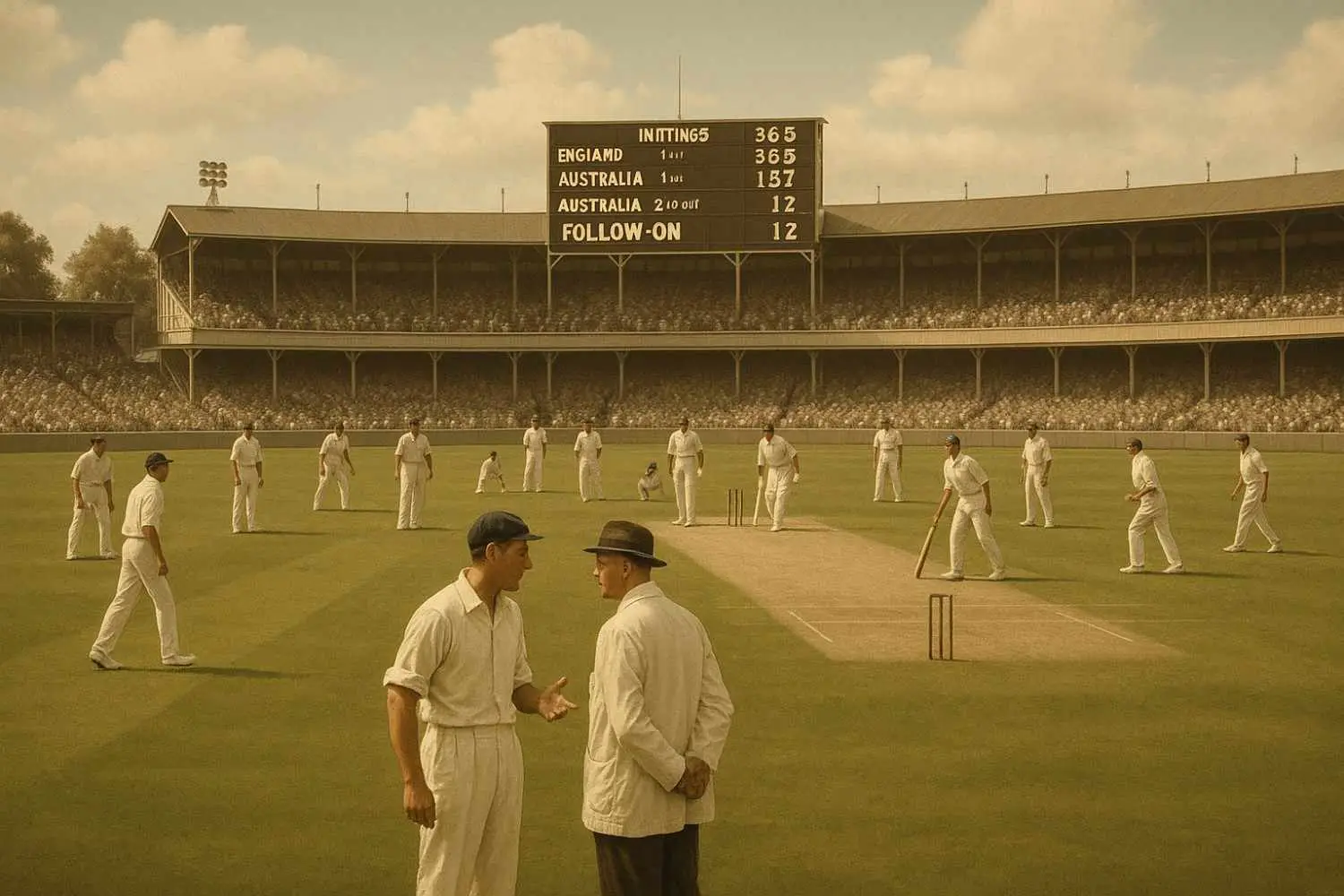Test cricket is known for its tradition, patience, and strategy. Among its many unique aspects, the follow-on rule stands out as one that can dramatically shift the flow of a match. Yet, it’s also one of the most misunderstood rules among casual fans. What does it mean when a team enforces the follow-on? When can it happen, and why do teams sometimes choose not to use it?
In this guide, we’ll break down the follow-on rule in Test cricket, its official conditions, the strategic reasoning behind it, and some of the most memorable moments involving the follow-on in cricket history.
What is the Follow-On Rule in Cricket?
In Test matches, each team typically gets to bat twice, once in each innings. The follow-on occurs when Team A, having batted first, gains a large first-innings lead over Team B. Instead of taking their second turn at batting immediately, Team A can ask Team B to bat again straightaway.
This rule exists to help the match result move forward, especially in situations where one team has dominated and there’s a risk of the game ending in a draw due to time constraints.
It’s a way of saying, “We’re so far ahead, we don’t need to bat again right now you go ahead and try to catch up.”
The Official ICC Follow-On Rule Explained
The International Cricket Council (ICC) governs the official rules of the game. According to Law 14 of the Laws of Cricket, a team may enforce the follow-on under specific circumstances, mainly depending on the lead they hold after the first innings.
Here’s how it works:
- In a 5-day Test match, the team bowling second can enforce the follow-on if they lead by 200 runs or more after the first innings.
- In 3- or 4-day matches, the lead required is 150 runs.
- In a 2-day match, a lead of 100 runs is required.
- For a 1-day match, the threshold is just 75 runs.
This rule only applies after both teams have completed their first innings. The decision to enforce the follow-on lies entirely with the captain of the team that holds the lead.
When Can the Follow-On Be Enforced?
To understand when a follow-on is even possible, let’s walk through a simple scenario:
- Team A bats first and scores 450 runs in their first innings.
- Team B then bats and scores 240 runs in their first innings.
- Since Team A leads by 210 runs, and this is a 5-day Test match, the lead is greater than 200.
- Team A can now choose to enforce the follow-on, meaning Team B has to bat again.
However, if Team B had scored, say, 255 runs, the lead would only be 195, and follow-on could not be enforced.
The rule is clear-cut, but the decision to actually use it is more complex and strategic.
Why Captains Enforce (or Don’t Enforce) the Follow-On
On paper, enforcing the follow-on sounds like a smart move. You’re already ahead, so why not push for a quick win?
But in reality, the follow-on can be a double-edged sword.
Captains must consider several factors:
1. Bowler Fatigue
If your bowlers have just toiled in the field for a long innings, enforcing the follow-on means asking them to go right back out there. In hot or humid conditions, this can increase the risk of injury or poor performance.
2. Pitch Deterioration
As the Test progresses, the pitch generally breaks down, especially in countries like India, where cracks and spin-friendly conditions develop by Day 4 or 5. If a team bats again instead of enforcing the follow-on, they may have a chance to put up a massive lead and bowl last on a crumbling pitch.
3. Psychological Pressure
Sometimes, forcing a team to bat again immediately can lead to panic and collapse. But other times, the batting team may regroup and put up a strong fight, shifting the momentum.
4. Time Left in the Game
If weather interruptions are likely or if too much time has already passed, enforcing the follow-on might be necessary to create a result. But if there’s enough time left, the leading team might choose to bat again, pile on the runs, and aim to bowl the opposition out with a massive lead.
Famous Matches Where the Follow-On Changed Everything
🏏 India vs Australia, Eden Gardens, 2001
This is perhaps the most iconic follow-on story in cricket history. Australia scored 445 in their first innings. India replied with just 171. Australia enforced the follow-on with a 274-run lead.
But then came VVS Laxman (281) and Rahul Dravid (180), who stitched together a historic partnership. India scored 657/7 declared and bowled out Australia for 212, winning the match after being forced to follow on.
It was only the third time in Test history that a team had won after being asked to follow on.
🏏 England vs Australia, Headingley, 1981 (The Botham Test)
Australia scored 401 and then bowled out England for 174. Australia enforced the follow-on. Then, Ian Botham scored an inspired 149 not out, and Bob Willis took 8 wickets to bowl Australia out for 111. England won by 18 runs.
This match is still considered one of the greatest comebacks of all time.
These matches show that enforcing the follow-on can be risky if the opposition bounces back, momentum can shift dramatically.
Has the Follow-On Rule Ever Changed?
The basic structure of the follow-on rule has remained largely unchanged for decades. However, the lead thresholds have been slightly adjusted over time to align with match lengths.
In modern cricket, captains are more cautious when using the follow-on. With increased awareness around bowler fitness, workload management, and strategic planning, enforcing the follow-on is no longer an automatic choice, even with a 200+ run lead.
Does the Follow-On Exist in Other Formats?
No. The follow-on rule is exclusive to multi-innings matches like:
- Test matches
- First-class cricket
- Some longer domestic formats
It does not apply to ODIs or T20 matches, where each team only bats once and there’s no possibility for enforcing a second innings.
Even in first-class cricket, follow-on enforcement is rare due to shorter match durations, and draws are more common.
Impact of Follow-On in Modern Test Cricket
In today’s game, follow-ons are still enforced but with more calculated risks. With weather forecasts, injury data, and pitch analytics available, captains now make more data-driven decisions.
For example, Ben Stokes, the current England Test captain, is known for his aggressive tactics. But even he has opted out of enforcing the follow-on in situations where the team wanted to bat again and set a target of 400+ to avoid any chance of a loss.
Final Thoughts
The follow-on rule in Test cricket is a fascinating part of the game’s strategic depth. It’s more than just a rule it’s a tactical decision that can lead to crushing victories or dramatic turnarounds.
Whether you’re a casual fan, a fantasy cricket player, or a seasoned follower of the game, understanding the follow-on gives you a deeper appreciation of the drama and tactics of Test cricket.









